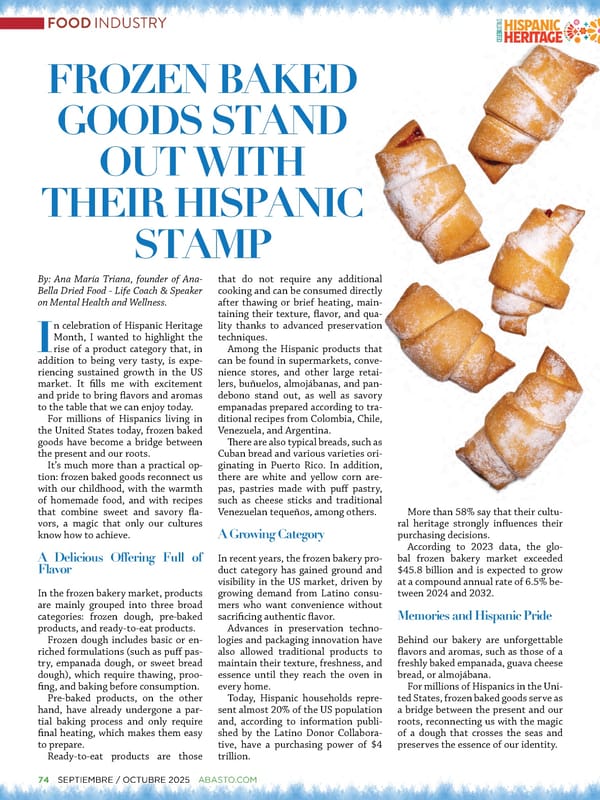74�SEPTEMBER / OCTOBER 2025�ABASTO.COM 74�SEPTIEMBRE / OCTUBRE 2025�ABASTO.COM FOOD INDUSTRY By: Ana María Triana, founder of Ana- Bella Dried Food - Life Coach & Speaker on Mental Health and Wellness. I n celebration of Hispanic Heritage Month, I wanted to highlight the rise of a product category that, in addition to being very tasty, is expe- riencing sustained growth in the US market. It flls me with excitement and pride to bring favors and aromas to the table that we can enjoy today. For millions of Hispanics living in the United States today, frozen baked goods have become a bridge between the present and our roots. It’s much more than a practical op- tion: frozen baked goods reconnect us with our childhood, with the warmth of homemade food, and with recipes that combine sweet and savory fa- vors, a magic that only our cultures know how to achieve. A Delicious Offering Full of Flavor In the frozen bakery market, products are mainly grouped into three broad categories: frozen dough, pre-baked products, and ready-to-eat products. Frozen dough includes basic or en- riched formulations (such as puf pas- try, empanada dough, or sweet bread dough), which require thawing, proo- fng, and baking before consumption. Pre-baked products, on the other hand, have already undergone a par- tial baking process and only require fnal heating, which makes them easy to prepare. Ready-to-eat products are those that do not require any additional cooking and can be consumed directly after thawing or brief heating, main- taining their texture, favor, and qua- lity thanks to advanced preservation techniques. Among the Hispanic products that can be found in supermarkets, conve- nience stores, and other large retai- lers, buñuelos, almojábanas, and pan- debono stand out, as well as savory empanadas prepared according to tra- ditional recipes from Colombia, Chile, Venezuela, and Argentina. Tere are also typical breads, such as Cuban bread and various varieties ori- ginating in Puerto Rico. In addition, there are white and yellow corn are- pas, pastries made with puf pastry, such as cheese sticks and traditional Venezuelan tequeños, among others. A Growing Category In recent years, the frozen bakery pro- duct category has gained ground and visibility in the US market, driven by growing demand from Latino consu- mers who want convenience without sacrifcing authentic favor. Advances in preservation techno- logies and packaging innovation have also allowed traditional products to maintain their texture, freshness, and essence until they reach the oven in every home. Today, Hispanic households repre- sent almost 20% of the US population and, according to information publi- shed by the Latino Donor Collabora- tive, have a purchasing power of $4 trillion. More than 58% say that their cultu- ral heritage strongly infuences their purchasing decisions. According to 2023 data, the glo- bal frozen bakery market exceeded $45.8 billion and is expected to grow at a compound annual rate of 6.5% be- tween 2024 and 2032. Memories and Hispanic Pride Behind our bakery are unforgettable favors and aromas, such as those of a freshly baked empanada, guava cheese bread, or almojábana. For millions of Hispanics in the Uni- ted States, frozen baked goods serve as a bridge between the present and our roots, reconnecting us with the magic of a dough that crosses the seas and preserves the essence of our identity. FROZEN BAKED GOODS STAND OUT WITH THEIR HISPANIC STAMP
 Abasto Magazine: September/October 2025 ENGLISH Page 89 Page 91
Abasto Magazine: September/October 2025 ENGLISH Page 89 Page 91